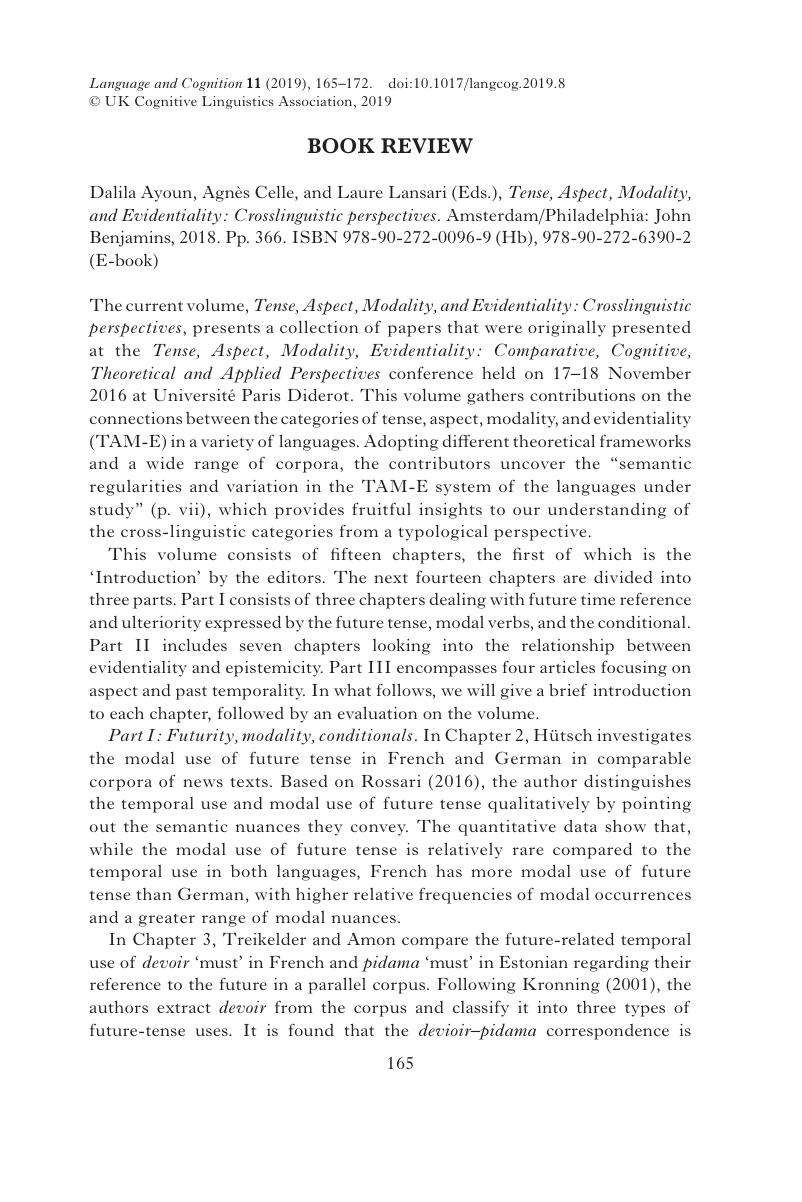No CrossRef data available.
Article contents
Dalila Ayoun, Agnès Celle, and Laure Lansari (Eds.), Tense, Aspect, Modality, and Evidentiality: Crosslinguistic perspectives. Amsterdam/Philadelphia: John Benjamins, 2018. Pp. 366. ISBN 978-90-272-0096-9 (Hb), 978-90-272-6390-2 (E-book)
Review products
Dalila Ayoun, Agnès Celle, and Laure Lansari (Eds.), Tense, Aspect, Modality, and Evidentiality: Crosslinguistic perspectives. Amsterdam/Philadelphia: John Benjamins, 2018. Pp. 366. ISBN 978-90-272-0096-9 (Hb), 978-90-272-6390-2 (E-book)
Published online by Cambridge University Press: 10 May 2019
Abstract
An abstract is not available for this content so a preview has been provided. Please use the Get access link above for information on how to access this content.

- Type
- Book Review
- Information
- Copyright
- Copyright © UK Cognitive Linguistics Association 2019
References
references
Bickel, B. (2007). Typology in the 21st century: major current developments. Linguistic Typology 11(1): 239–251.CrossRefGoogle Scholar
Bickel, B. (2015). Distributional typology: statistical inquiries into the dynamics of linguistic diversity. In Bernd, H. & Heiko, N. (Eds.), Oxford handbook of linguistic analysis (pp. 901–923). Oxford: Oxford University Press.Google Scholar
Bybee, J., Perkins, R., & Pagliuca, W. (1994). The evolution of grammar. Chicago, IL: University of Chicago Press.Google Scholar
Cornillie, B. (2009). Evidentiality and epistemic modality: on the close relationship between two different categories. Functions of Language 16(1), 44–62.Google Scholar
de Haan, F. (1999). Evidentiality and epistemic modality: setting boundaries. Southwest Journal of Linguistics 18, 83–101.Google Scholar
Gries, S. T., & Hilpert, M. (2008). The identification of stages in diachronic data: variability-based neighbor clustering. Corpora 3(1), 59–81.CrossRefGoogle Scholar
Hennemann, A. (2012). The epistemic and evidential use of Spanish modal adverbs and verbs of cognitive attitude. Folia Linguistica 46(1), 133–170.CrossRefGoogle Scholar
Kennedy, C., & Levin, B. (2008). Measure of change: the adjectival core of degree achievements. In McNally, L. & Kennedy, C. (Eds.), Adjectives and adverbs: syntax, semantics and discourse (pp. 156–182). Oxford: Oxford University Press.Google Scholar
Kronning, H. (2001). Pour une tripartition des emplois du modal devoir. Cahiers Chronos 8, 67–84.Google Scholar
Lyu, S., & Wang, Y. (2018). Review of Evidentiality revisited: cognitive grammar, functional and discourse-pragmatic perspectives. Cognitive Linguistics 29(4), 843–852.CrossRefGoogle Scholar
Nilsson-Ehle, H. (1943). Le conditionnel ‘futur du passé’ et la périphrase devait + infinitif. Studia Neophilologica 16, 50–88.CrossRefGoogle Scholar
Nuyts, J. (2001). Epistemic modality, language and conceptualization. Amsterdam: John Benjamins.CrossRefGoogle Scholar
Nuyts, J. (2017). Evidentiality reconsidered. In Marín Arrese, J. I., Haßler, G., & Carretero, M. (Eds.), Evidentiality revisited: cognitive grammar, functional and discourse-pragmatic perspectives (pp. 57–83). Amsterdam: John Benjamins.CrossRefGoogle Scholar
Rossari, C. (2016). Les fluctuations de sens dans quelques formes modales à la lumière d’une approche quantitative et qualitative. Studii de Lingvistică 6, 127–142.Google Scholar
Squartini, M. (2004). Disentangling evidentiality and epistemic modality in romance. Lingua 114(7), 873–889.CrossRefGoogle Scholar




